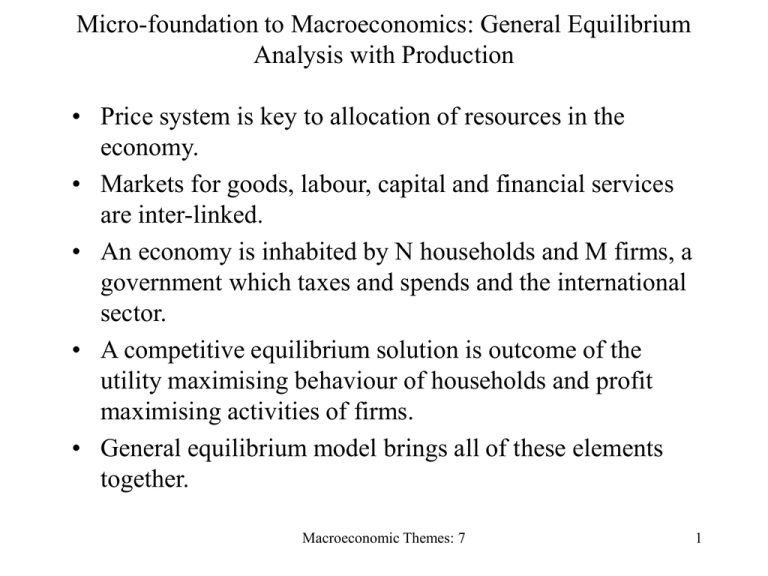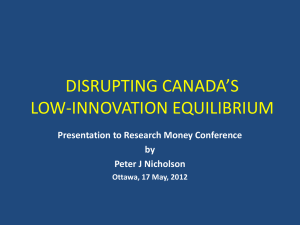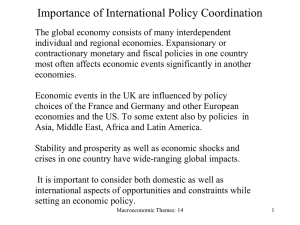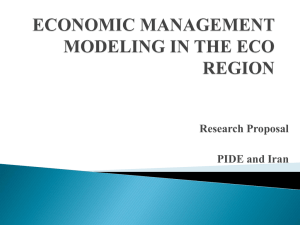Micro-foundation to Macroeconomics: General Equilibrium Analysis
advertisement

Micro-foundation to Macroeconomics: General Equilibrium Analysis with Production • Price system is key to allocation of resources in the economy. • Markets for goods, labour, capital and financial services are inter-linked. • An economy is inhabited by N households and M firms, a government which taxes and spends and the international sector. • A competitive equilibrium solution is outcome of the utility maximising behaviour of households and profit maximising activities of firms. • General equilibrium model brings all of these elements together. Macroeconomic Themes: 7 1 General Equilibrium in Terms of Circular Flows Households C+S+T=HI Financial market I=S Factor Market Ld =LS Kd = KS Government R=G Goods market Y=C+I+G+M -M Firms Rest of the World CA+KA=0 Y=F(A,K,L) Macroeconomic Themes: 7 2 General Macroeconomic Equilibrium LD IS W i=i* LS M(D) i LM L Labor market IS-LM: goods and money Money market (M/P) F(Y) Y P Y Output L Output to output , Y Macroeconomic Themes: 7 Price level and money supply 3 General Equilibrium Impacts of Labour Supply Tax Labour market W/P LD LS1 LS (a) L1 L D D1 S S1 Y (c) Y1 (b) Employment and production P P1 P2 Demand and Supply of Goods Macroeconomic Themes: 7 4 Simple Micro-founded macro model on welfare impact of taxes Max U(C, L) HouseholdsL- Government Factors -Labour Goods consumption Firms Macroeconomic Themes: 7 5 Main Features of the model Households: Representative and heterogenous cases Fixed endowment of time ES preferences on consumption and leisure Utility maximisers Firms Profit maximisers Cobb-Douglas technology Government Collects sales and income taxes Spends on public goods Markets: Competitive equilibrium Goods market clears –through price and quantity adjustment Labour market clears through labour-leisure choice decision Capital market clear: all capital is used in production Assumes a closed economy or global economy No money illusion Policy evaluation criteria Comparative static analysis with equivalent or Efficiency effect of taxes by change in P, r and W and reallocation C, L, LS, Y, I, R Macroeconomic Themes: 7 6 Household’s Problem Max U c l1 Subject to: i. l L 1 time constraint ii. c w1 l rK budget constraint iii. c 0; l 0; K 0 non-negativity constraint where c is consumption, l is leisure and L is labour supply, K is capital stock, p is the price of the commodity which is normalised to 1, w is the wage rate is the profit from owning the firm. Macroeconomic Themes: 7 7 Firm’s Problem Max py wLd rK subject to : i. y AK L1 technology constraint ii. y 0; L 0; K 0 non negativity constraint where y is the output supplied by the firm and Ld is its demand for labour, is the share of capital or 1 is the elasticity of output to the capital input and the share of labour in production. Capital stock is constant in the short run. Macroeconomic Themes: 7 8 Demand side of the economy L c,l, c l1 w1 l rK c L c,l, c 1l1 c L c,l, 1 c l w l L c,l, w1 l rK c Macroeconomic Themes: 7 (1) (2) (3) 9 Demand for Consumption Demand for consumption goods can be derived by using the marginal rate of substitution between leisure and consumption (dividing FOC (2) by FOC (1) and solving for c): L c, l, 1 c l 1 l w c l w cw 1 l L c, l, c 1l1 c (4) there is more demand for the consumption goods when the wage rate is higher or the leisure is less demanded when the wage rate is higher. Macroeconomic Themes: 7 10 Demand for Leisure We obtain the demand for leisure using this result in the budget constraint w l w 1 l rK wl 1 w rK => 1 1 l 1w w rK (5) l or Substituting (5) into (4) c w 1 c w 1w w rK => c w rK 1 Macroeconomic Themes: 7 (6) 11 Supply Side of the Economy Max py wL d rK Max AK L1 wL rK First order conditions for optimisation: 0 AK 1L1 r (7) K 0 1 AK L w (8) L AK 1L1 r From (7) and (8) we get w 1 AK L 1 r Lr L w K 1 K w Macroeconomic Themes: 7 (9) 12 Market Clearing Conditions SK The capital market clearing condition: N .K M .K K=K when N=M. r The labour market clearing 1 l L DK Goods market clearing implies c y SL K S w P D DL Y L Macroeconomic Themes: 7 13 Three Different Condition for a General Equilibrium 1. market for goods, labour and capital clear; that means prices (p, w, r) adjust until demand and supply are equal in each of these market. No excess supply or excess demand exists in any of these markets. 2. Firms continue producing until the economic profit is zero (competitive equilibrium) 3. Income of household exactly balances to the expenditure and total labour supply is exactly divided between labour and leisure. Macroeconomic Themes: 7 14 Labour Market Equilibrium Using labour market clearing condition and (5) above in (9) we have r K (10) 11w w rK 1 w 1 w 1 w rK rK rK w w 1 rK 1 1 rK This solves as w rK 1 (11) Substitute (11) in (7) to get the equilibrium interest rate 1 AK L w 1 AK 1 r K w Macroeconomic Themes: 7 w 15 Determination of equilibrium interest and other quantities in the equilibrium 1 AK 1 rK w1 1 AK r w1 1 1 AK r w 1 r 1 1 1 1 w r A 1 Macroeconomic Themes: 7 (12) 16 Equilibrium Relative Wage Rate Substituting (12) into (11) yields w rK 1 1 1 1 K w A 1 w 1 1 11 1 K w A1 1 1 K * w 1 A1 (13) Macroeconomic Themes: 7 17 Determination of Equilibrium Quantities Use (13) to find the optimal values of labour, capital stock and output and consumption in this economy. The optimal capital stock is obtained by using r and w in equation (10). The optimal labour supply is obtained by using that value of K in (9). Once K, and L are determined output is determined from the production function. By market clearing condition the consumption equals output. Macroeconomic Themes: 7 18 Simulation of the Model to a Change in Capital Stock and Technology Parameterisation and base case soultion K-stock alpha 0.5 beta 0.3 Technolog y 0.7 4 Sensitivity of the General Equilibrium Results to Capital Stock and the Technlology wage rate interest rate Labour Output Profit Leisure Consumption Utility L-income K-income Total income Impact of increasing capital stock(K) 0.500 1.000 2.000 0.656 0.808 0.995 0.349 0.215 0.132 0.620 0.620 0.620 0.581 0.716 0.881 0.000 0.000 0.000 0.380 0.380 0.380 0.581 0.716 0.881 0.512 0.592 0.685 0.407 0.501 0.617 0.174 0.215 0.264 0.581 0.716 0.881 4.000 1.224 0.081 0.620 1.085 0.000 0.380 1.085 0.792 0.759 0.325 1.085 Impact of technological improvement (A) base case 2.000 3.000 4.000 0.656 1.616 2.424 3.231 0.349 0.085 0.050 0.034 0.620 0.123 0.048 0.024 0.581 0.461 0.357 0.298 0.000 0.177 0.192 0.185 0.380 0.877 0.952 0.976 0.581 1.191 1.731 2.286 0.512 1.086 1.447 1.770 0.407 0.199 0.116 0.079 0.174 0.085 0.050 0.034 0.581 0.284 0.165 0.113 Macroeconomic Themes: 7 19 Tax distortions 1 t c 1 t w1 l 1 t rK l k (14) t is the value added tax rate, tl is the labour income tax rate and tk is the capital income tax rate L c, l, c l1 1 t w1 l 1 t rK 1 t c (15) l k y c g (16) g t wL t rK tc l k (17) Now apply the first order conditions (1)-(3) in order to get the demand side of the tax distorted economy. Also consider that the market clearing condition now should include both private and public demand goods. Macroeconomic Themes: 7 20 Reference: 1. Arrow, K.J. and G. Debreu (1954) “Existence of an Equilibrium for a Competitive Economy” Econometrica 22, 265-90. 2. Bhattarai K. (2002) Welfare Impacts of Equal-yield Tax Reforms in the UK Economy, mimio, University of Hull. 3. Bhattarai K. (2002) Macroeconomic impacts of taxes, mimio, University of Hull. 4. Bhattarai K. (2001) A Prototype Multi-Sectoral Multi-household General equilibrium Tax Model, Hull Advances in Policy Economics Working paper no. 9. 5. Bhattarai K. and J. Whalley (1999) “Role of labour demand elasticities in tax incidence analysis with hetorogeneous labour” Empirical Economics, 24:4, pp.599-620. 6. Bhattarai and J Whalley (2000) “General Equilibrium Modelling of UK Tax Policy” in S. Holly and M Weale (Eds.) Econometric Modelling: Techniques and Applications, pp.69-93, the Cambridge University Press, 2000. 7. Lau M.L. A. Pahlke and T.F. Rutherford(2002), Approximating infinite-horizon models in a complementarity format: A primer in dynamic general equilibrium analysis, Journal of Economic Dynamics and Control 26 577-609. 7. Parente Stephen L. 1994, Technology Adoption, Learning-by-Doing, and Economic Growth, Journal of Economic Theory, 63, pp. 346-369. 8. Ramsey, F.P. (1928) “A Mathematical Theory of Saving,” Economic Journal 38, 543-559. 9. Rutherford, T. F. (1995) “Extension of GAMS for Complementary Problems Arising in applied Economic Analysis” Journal of Economic Dynamics and Control 19 12991324. 10. Shoven, J.B. and J.Whalley (1992) Applying General Equilibrium, Cambridge University Press, 1992. Macroeconomic Themes: 7 21










